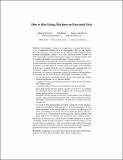How to Run Turing Machines on Encrypted Data
Author(s)
Goldwasser, Shafi; Kalai, Yael Tauman; Popa, Raluca Ada; Vaikuntanathan, Vinod; Zeldovich, Nickolai
DownloadZeldovich_How to run.pdf (329.0Kb)
OPEN_ACCESS_POLICY
Open Access Policy
Creative Commons Attribution-Noncommercial-Share Alike
Terms of use
Metadata
Show full item recordAbstract
Cryptographic schemes for computing on encrypted data promise to be a fundamental building block of cryptography. The way one models such algorithms has a crucial effect on the efficiency and usefulness of the resulting cryptographic schemes. As of today, almost all known schemes for fully homomorphic encryption, functional encryption, and garbling schemes work by modeling algorithms as circuits rather than as Turing machines.
As a consequence of thismodeling, evaluating an algorithmover encrypted data is as slow as the worst-case running time of that algorithm, a dire fact for many tasks. In addition, in settings where an evaluator needs a description of the algorithm itself in some “encoded” form, the cost of computing and communicating such encoding is as large as the worst-case running time of this algorithm.
In this work, we construct cryptographic schemes for computing Turing machines on encrypted data that avoid the worst-case problem. Specifically, we show:
An attribute-based encryption scheme for any polynomial-time Turing machine and Random Access Machine (RAM).
A (single-key and succinct) functional encryption scheme for any polynomialtime Turing machine.
A reusable garbling scheme for any polynomial-time Turing machine. These three schemes have the property that the size of a key or of a garbling for a Turing machine is very short: it depends only on the description of the Turing machine and not on its running time. Previously, the only existing constructions of such schemes were for depthd circuits, where all the parameters grow with d. Our constructions remove this depth d restriction, have short keys, and moreover, avoid the worst-case running time.
A variant of fully homomorphic encryption scheme for Turing machines, where one can evaluate a Turing machine M on an encrypted input x in time that is dependent on the running time of M on input x as opposed to the worstcase runtime of M. Previously, such a result was known only for a restricted class of Turing machines and it required an expensive preprocessing phase (with worst-case runtime); our constructions remove both restrictions.
Our results are obtained via a reduction from SNARKs (Bitanski et al) and an “extractable” variant of witness encryption, a scheme introduced by Garg et al.. We prove that the new assumption is secure in the generic group model. We also point out the connection between (the variant of) witness encryption and the obfuscation of point filter functions as defined by Goldwasser and Kalai in 2005.
Date issued
2013Department
Massachusetts Institute of Technology. Computer Science and Artificial Intelligence Laboratory; Massachusetts Institute of Technology. Department of Electrical Engineering and Computer ScienceJournal
Advances in Cryptology – CRYPTO 2013
Publisher
Springer-Verlag Berlin Heidelberg
Citation
Goldwasser, Shafi, Yael Tauman Kalai, Raluca Ada Popa, Vinod Vaikuntanathan, and Nickolai Zeldovich. (2013). “How to Run Turing Machines on Encrypted Data.” in Ran Canetti, Juan A. Garay (Eds.) "Advances in Cryptology – CRYPTO 2013, Part II." (pp.536-553). Berlin: Springer. (Lecture Notes in Computer Science; volume 8043).
Version: Author's final manuscript
ISBN
978-3-642-40083-4
978-3-642-40084-1
ISSN
0302-9743
1611-3349